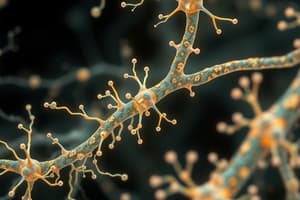Podcast
Questions and Answers
What is the primary function of the hypothalamus?
What is the primary function of the hypothalamus?
- Regulating body temperature, thirst, and appetite (correct)
- Interpreting vision and hearing
- Processing speech and reasoning
- Controlling fine movements of the body
What is the function of the midbrain?
What is the function of the midbrain?
- Acting as a relay station for tracts passing between the cerebrum and spinal cord (correct)
- Processing speech and emotions
- Interpreting sensory input from the eyes, ears, and joints
- Regulating body temperature and appetite
Which part of the brain is responsible for controlling sex drive?
Which part of the brain is responsible for controlling sex drive?
- Cerebellum
- Medulla oblongata
- Cerebrum
- Hypothalamus (correct)
What is the function of the reflex centers in the brain stem?
What is the function of the reflex centers in the brain stem?
Which part of the brain is separated from the brain stem by the fourth ventricle?
Which part of the brain is separated from the brain stem by the fourth ventricle?
What is the function of the pons?
What is the function of the pons?
Which part of the brain is responsible for fine control of movement?
Which part of the brain is responsible for fine control of movement?
What is the function of the medulla oblongata?
What is the function of the medulla oblongata?
What is the primary function of sensory receptors in the human nervous system?
What is the primary function of sensory receptors in the human nervous system?
What is the main difference between the central nervous system and the peripheral nervous system?
What is the main difference between the central nervous system and the peripheral nervous system?
What is the role of neuromuscular junctions?
What is the role of neuromuscular junctions?
What is the primary function of the central nervous system?
What is the primary function of the central nervous system?
What is the characteristic of central nervous tissue that makes it fragile?
What is the characteristic of central nervous tissue that makes it fragile?
What is the purpose of the four major features that protect the central nervous system?
What is the purpose of the four major features that protect the central nervous system?
What is the main function of the peripheral nervous system?
What is the main function of the peripheral nervous system?
What is the role of the spinal cord in the human nervous system?
What is the role of the spinal cord in the human nervous system?
What does the word 'pons' mean in Latin?
What does the word 'pons' mean in Latin?
What is the function of the pons in the brain?
What is the function of the pons in the brain?
What happens to the pupils when light intensity increases?
What happens to the pupils when light intensity increases?
What is the purpose of the activity involving observing the size of the pupil?
What is the purpose of the activity involving observing the size of the pupil?
What is the pathway of light through the eye?
What is the pathway of light through the eye?
What is the function of the light-sensitive cells in the retina?
What is the function of the light-sensitive cells in the retina?
What is the name of the nerve that carries impulses from the eye to the brain?
What is the name of the nerve that carries impulses from the eye to the brain?
What happens to the pupils immediately after removing the cover from the eyes?
What happens to the pupils immediately after removing the cover from the eyes?
What is the function of the pinna in the human ear?
What is the function of the pinna in the human ear?
What is the name of the thin membrane at the end of the ear canal?
What is the name of the thin membrane at the end of the ear canal?
What is the purpose of the Activity 5.30?
What is the purpose of the Activity 5.30?
What is the name of the tube in the human ear?
What is the name of the tube in the human ear?
What is the main function of the ear?
What is the main function of the ear?
What is the length of the human ear canal?
What is the length of the human ear canal?
What is the name of the part of the ear that is visible externally?
What is the name of the part of the ear that is visible externally?
What is the function of the inner ear?
What is the function of the inner ear?
What is the name of the membrane in the ear that vibrates to sound?
What is the name of the membrane in the ear that vibrates to sound?
What is the main cavity of the ear between the eardrum and the inner ear?
What is the main cavity of the ear between the eardrum and the inner ear?
What is the function of the eardrum?
What is the function of the eardrum?
What is the name of the structure shown in Figure 5.30?
What is the name of the structure shown in Figure 5.30?
Flashcards are hidden until you start studying
Study Notes
Nervous System
- The human nervous system has two main parts: the central nervous system (CNS) and the peripheral nervous system.
- The CNS consists of the brain and spinal cord.
- The peripheral nervous system consists of nerves that branch out from the brain and spinal cord.
Brain
- The brain is protected by hard, bony structures and has four major features that help protect it from injury.
- The brain performs higher functions such as interpreting touch, vision, and hearing, as well as speech, reasoning, emotions, learning, and fine control of movement.
Cerebrum
- The cerebrum is the largest part of the brain and is divided into two hemispheres.
- The hypothalamus is the center for homeostatic control of the internal environment and regulates thirst, appetite, and body temperature.
Cerebellum
- The cerebellum is located under the occipital lobe and is separated from the brain stem by the fourth ventricle.
- It receives sensory input from the eyes, ears, joints, and muscles about the present position of body parts.
Brain Stem
- The brain stem connects the cerebrum to the spinal cord and consists of the midbrain, pons, and medulla oblongata.
- The midbrain acts as a relay station for tracts passing between the cerebrum and the spinal cord or cerebellum.
- The pons contains bundles of axons traveling between the cerebellum and the rest of the CNS.
Sensory Receptors
- Sensory receptors are nerve endings that can sense stimuli, such as pressure, pain, temperature, and start a nerve impulse.
Synapses
- Special types of synapses include neuromuscular junctions, which play a crucial role in the transmission of nerve impulses to muscles.
Neurotransmitters
- Neurotransmitters are chemical messengers that transmit signals between neurons and play a crucial role in the nervous system.
Eye
- The eye has a pupil that changes size in response to light intensity.
- The pupil constricts in bright light and dilates in low light.
Ear
- The ear is divided into three regions: the outer ear, middle ear, and inner ear.
- The outer ear consists of a flap called a pinna (auricle).
- The middle ear contains the eardrum and the inner ear contains the cochlea and semicircular canals.
Eye Defects
- Types of human eye defects include cataracts and glaucoma, which can be resolved with medical treatment.
Traditional Mechanisms
- Traditional mechanisms used to regulate body homeostasis in different localities may vary, and discussing these mechanisms in small groups can help identify unique approaches to maintaining body equilibrium.
Studying That Suits You
Use AI to generate personalized quizzes and flashcards to suit your learning preferences.




